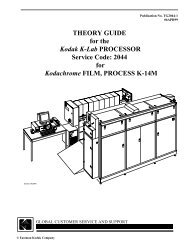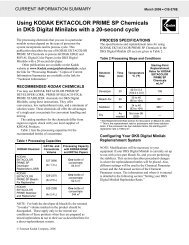KODAK T-MAX Professional Films - 125px
KODAK T-MAX Professional Films - 125px
KODAK T-MAX Professional Films - 125px
You also want an ePaper? Increase the reach of your titles
YUMPU automatically turns print PDFs into web optimized ePapers that Google loves.
DARKROOM RECOMMENDATIONS<br />
Do not use a safelight. Handle unprocessed film in total<br />
darkness. Do not develop this film by inspection.<br />
Note: Some darkroom timers will glow (fluoresce) for some<br />
time after you turn off the lights in a darkroom. To avoid<br />
fogging this film, turn the face of timers away from the area<br />
where you handle unprocessed film.<br />
The afterglow from fluorescent lights will also fog this<br />
film. Make sure your darkroom is completely dark before<br />
you handle unprocessed film.<br />
STORAGE AND HANDLING<br />
<strong>KODAK</strong> T-<strong>MAX</strong> P3200 <strong>Professional</strong> Film is very sensitive<br />
to environmental radiation; expose and process it promptly.<br />
Request visual inspection of this film at airport x-ray<br />
inspection stations.<br />
Store unexposed film at 75°F(24°C) or lower in the<br />
original sealed package. For protection from heat in areas<br />
with temperatures consistently higher than 75°F(24°C), you<br />
can store the film in a refrigerator. If film has been<br />
refrigerated, allow the package to warm up to room<br />
temperature for 1 to 1 1 ⁄2 hours before opening it.<br />
Load and unload your camera in subdued light, and<br />
rewind the film completely before unloading the camera.<br />
Store processed film in a cool, dry place.<br />
EXPOSURE<br />
<strong>KODAK</strong> T-<strong>MAX</strong> P3200 <strong>Professional</strong> Film is specially<br />
designed to be used as a multi-speed film. The speed you use<br />
depends on your application; make tests to determine the<br />
appropriate speed.<br />
The nominal speed is EI 1000 when the film is processed<br />
in <strong>KODAK</strong> T-<strong>MAX</strong> Developer or <strong>KODAK</strong> T-<strong>MAX</strong> RS<br />
Developer and Replenisher, or EI 800 when it is processed in<br />
other Kodak black-and-white developers. It was determined<br />
in a manner published in ISO standards. For ease in<br />
calculating exposure and for consistency with the commonly<br />
used scale of film-speed numbers, the nominal speed has<br />
been rounded to EI 800.<br />
Because of its great latitude, you can expose this film at<br />
EI 1600 and yield negatives of high quality. There will be no<br />
change in the grain of the final print, but there may be a slight<br />
loss of shadow detail. When you need a higher speed, you<br />
can expose this film at EI 3200 or 6400. At these speeds,<br />
there will be a slight increase in contrast and graininess with<br />
additional loss of shadow detail. (See the processing tables<br />
for adjusted development times.)<br />
Because of the shape of the characteristic curve of the<br />
film, you will obtain better shadow detail and highlight<br />
separation when you expose it at EI 3200 or 6400 than you<br />
can obtain with 400-speed films pushed by 3 stops. These<br />
higher speeds allow you to take photographs in many<br />
situations where photography was previously impossible.<br />
<strong>KODAK</strong> T-<strong>MAX</strong> P3200 <strong>Professional</strong> Film<br />
To expose this film at speeds higher than EI 6400, it is<br />
critical that you make tests to determine if the results are<br />
appropriate for your needs. For best results when you expose<br />
the film at these speeds, use T-<strong>MAX</strong> Developer or T-<strong>MAX</strong><br />
RS Developer and Replenisher.<br />
Note: Contrast and graininess will increase when you use<br />
higher exposure indexes.<br />
To expose film at speed settings that are higher than the<br />
maximum setting on your camera or meter, set the meter at a<br />
lower speed; then reduce the aperture or increase the shutter<br />
speed to compensate.<br />
You can also expose this film at EI 400 and obtain<br />
outstanding shadow detail. See the processing tables.<br />
The speed numbers for this film are expressed as<br />
Exposure Indexes (EI). Use these exposure indexes with<br />
meters or cameras marked for ISO/ASA or ISO°/DIN speeds<br />
in daylight or artificial light.<br />
<strong>KODAK</strong> T-<strong>MAX</strong> P3200 <strong>Professional</strong> Film<br />
<strong>KODAK</strong> Developer or<br />
Developer and<br />
Exposure Index (EI)<br />
Replenisher<br />
T-<strong>MAX</strong> or<br />
T-<strong>MAX</strong> RS<br />
800/30°<br />
1600/33°<br />
3200/36°<br />
6400/39°<br />
12,500/42° *<br />
25,000/45° *<br />
* Expose and process a test roll to determine if results at these exposure<br />
indexes are acceptable for your needs.<br />
<strong>KODAK</strong> T-<strong>MAX</strong> <strong>Professional</strong> <strong>Films</strong> • F-32 17<br />
XTOL<br />
D-76<br />
HC-110 (Dil B)<br />
DURAFLO RT<br />
800/30°<br />
1600/33°<br />
3200/36°<br />
6400/39°<br />
800/30°<br />
1600/33°<br />
3200/36°<br />
6400/39°<br />
800/30°<br />
1600/33°<br />
3200/36°<br />
6400/39°<br />
800/30°<br />
1600/33°<br />
3200/36°<br />
6400/39°

















